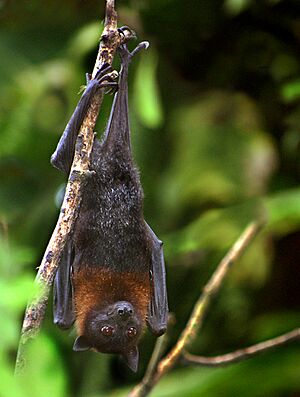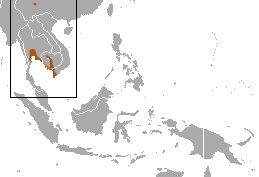Lyle's flying fox facts for kids
Quick facts for kids Lyle's flying fox |
|
|---|---|
 |
|
| Conservation status | |
| Scientific classification | |
| Genus: |
Pteropus
|
| Species: |
lylei
|
 |
|
| Lyle's flying fox range | |
Lyle's flying fox (Pteropus lylei) is a type of large bat. It belongs to a family called Pteropodidae, which includes many "flying foxes." These bats get their name because their faces look a bit like a fox.
You can find Lyle's flying foxes in countries like Cambodia, Thailand, and Vietnam. Some also live in Yunnan, China. Farmers sometimes try to get rid of them to protect their crops. In some areas, people also hunt them for food. Because of these threats, experts say Lyle's flying fox is a "vulnerable" species. This means it could become endangered if we don't protect it.
Contents
What Does Lyle's Flying Fox Look Like?
Lyle's flying fox is a medium-sized bat. It has a long nose, big eyes, and pointy ears. Its face looks a bit like a fox!
Most of its upper body is black. It has a wide collar of orange fur around its neck. Sometimes, its lower body can be dark brown or yellowish-brown. Its wings are black or dark brown, and its belly is dark brownish-black.
Where Do These Bats Live?
Lyle's flying fox lives only in certain parts of southern Asia. Its home range stretches from southern Thailand through central and southern Cambodia. It also lives in the very southwestern part of Vietnam. A few have been found in Yunnan Province in China.
These bats like to live together in large groups. They often rest, or "roost," in tropical and subtropical forests. They can also be found in mangrove forests, plantations, and other types of forests that have grown back.
The Bat Pagoda Colony
There is a huge group of thousands of these bats in Sóc Trăng city, Vietnam. This colony includes both Lyle's flying foxes and large flying foxes. They live at a place called the Bat Pagoda (Khmer Chùa Dơi).
At the pagoda, the bats roost in trees within the temple grounds. The monks who live there protect the bats.
What Do Lyle's Flying Foxes Eat?
Like other flying foxes, Lyle's flying fox loves to eat fruit. Their diet includes fruits like mango, cashew, monkey jack, sapodilla, dragonfruit, Java apple, tamarind, jambolan, and roseapple.
When they eat fruit, they chew it and spit out most of the seeds. However, some seeds are swallowed and pass through the bat. This helps spread the seeds, allowing new plants to grow. These bats also eat flowers, nectar, and pollen. When they search for food, they visit orchards. They can fly up to 50 kilometers (about 31 miles) between their resting places and feeding spots.
Daily Life and Health
Lyle's flying foxes feed at night. But even during the day, their roosting colonies in the trees are quite busy. Mothers feed their young, and the bats move around and make sounds.
These bats can carry the Nipah virus. This virus causes a new disease that affects the brain and breathing. It was first found in 1998. The virus does not harm the bats themselves. However, it can cause a very serious and even deadly disease in pigs and humans.
Why Are These Bats Vulnerable?
The trees where Lyle's flying foxes roost can lose their leaves. If new trees are not planted, the old trees might die, which threatens the bats' homes. Another big threat is hunting. People hunt these bats in Thailand and Cambodia. Farmers across their range also try to harm them to protect their fruit orchards.
The International Union for Conservation of Nature estimates that the number of Lyle's flying foxes has dropped by more than 30% in the last fifteen years. Because of these reasons, the conservation status of this flying fox is listed as "vulnerable." This means they need our help to survive.


